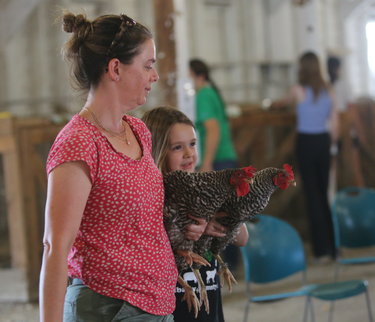City and country kids will explore the Altamont Fair compliments of a $25K state grant
ALTAMONT — Eighty kids in matching T-shirts will be part of the crowd on opening day, Aug. 12, of the Altamont Fair this year.
Half of them will be from rural Berne-Knox-Westerlo and the other half from Eagle Point Elementary School in Albany.
“We’re going to show them, behind the scenes, how the fair works,” said Pat Canaday, a spokeswoman for the fair.
The Altamont Fair is receiving $25,000 from the state to fund the program.
On Monday, the state’s agriculture commissioner, Richard Ball, announced $2 million in funds to boost New York’s 50 county and local agricultural fairs.
New this year is the Transportation for Youth to Local and County Fairs Program, which awarded over $300,000 to 15 organizations including the Albany, Schenectady, Greene Counties Agricultural and Historical Society, which is the formal name for Altamont’s tri-county fair.
A pilot program was launched last year at the Boonville Oneida County Fair “with the goal of enhancing youth participation in, and appreciation of, agriculture and the domestic arts,” according to a release from the state’s Department of Agriculture and Markets.
Amy Anderson, the Altamont Fair’s director, has put together an “amazing program” for the day that the city and country kids explore the Altamont Fair, Canaday told The Enterprise on Monday. “Amy’s two passions are agriculture and kids,” said Canaday.
“We always try to get people involved, especially young people,” she said.
The kids will see the raised-bed gardens behind the grandstand where vegetables are grown for local food pantries. “Our goal is to connect people with fresh food and what better way to do that than a food distribution center that already serves people who may not have those advantages,” said Canaday.
The 40 children will also visit each of the animal barns “so they can get up close and personal with the animals,” said Canaday.
Each child will be given an “ag swag” bag and they’ll eat fair food, compliments of the grant, before they go to the midway in the afternoon for free rides.
Berne-Knox-Westerlo is reaching out to the third of its elementary-school students who fall below the poverty line, Canaday said, while Eagle Point Elementary School is sending the entire class that is going into second grade. (The State Education Department reports that 39 percent of BKW students are economically disadvantaged while 62 percent of Eagle Point students are.)
“Studies show that there are a lot of rural kids, even though they live nearby, for a variety of reasons, that don’t get to go to the county fairs,” said Canaday.
Canaday went on, “Part of the fair is, like, bringing a pie and competing with others to see if you have the best pie or the best animal. And so we’ve invited all of the children — we’ve left it up to their teachers how to do it — to bring something they’ve made whether it’s an art project or a photography project or a little building project with Legos or birdhouses or whatever.”
Their work will be displayed in the Ag and Science Building. “They can come and see their own stuff where everybody’s going to enjoy it,” Canaday said.
Once the children feel the excitement of coming to the fair, Canaday said, “a lot of kids will want to come back again the following year and be involved and maybe enter something else they’ve created … Once people get connected, they’ll realize we’re not that far away from where they live, they’ll learn more about us and agriculture in general.”
Canaday went on, “It really fits with the Altamont Fair’s mission, trying to share agriculture and history with our communities.”
To further this mission, Canaday noted, the fair has an Ag Awareness Trail and a scavenger hunt, which “gives kids a nice grounded way of looking at the fair from an agricultural point of view” and ends with prizes.
Canaday concluded, “We’re finding in the fast-paced world we live in that, as much as we think [the fair] is the center of our world, it’s just not the center of other people’s world. People need to see baby animals and have empathy for animals and a knowledge of where their food comes from. It’s an ongoing educational project.”
State perspective
Additionally, county and local fairs across New York are receiving $500,000 for promotion, and the state has launched another year of its $1 million marketing campaign to encourage New Yorkers to visit their local fairs.
“Our county and local fairs are the backbones of communities across the state and represent an incredible avenue to connect people to the rich past, present, and future of New York agriculture,” said commissioner Ball in a release announcing the awards. “I’m excited to continue our support of county fairs, including a unique new program that helps bring more young people to experience the tradition of their local fair. I’m looking forward to seeing the impact that these programs have during the 2025 season.”
The state’s marketing and advertising campaign, “BEST DAY EVER (ALL SUMMER LONG),” invites people to witness the “transformation of an ordinary field into an extraordinary celebration of summer” at local fairs across the state.
A portion of the campaign will focus on encouraging exhibitor participation at each of the fairs. Messaging will be delivered through social media ads on Facebook and Instagram, as well as placements in the NY Morning Ag Clips newsletter.
Also, the state’s Passport Program, which is meant to encourage people to visit more than one fair, is entering its second year this fair season.
Passports may be picked up at county fairs in addition to select local county Cornell Cooperative Extension offices, State Welcome Centers, and State Parks. Fairgoers can bring their passports to any of the fairs they visit and get a unique stamp in their booklet as well as “Ag Swag,” which includes lanyards and commemorative buttons.



